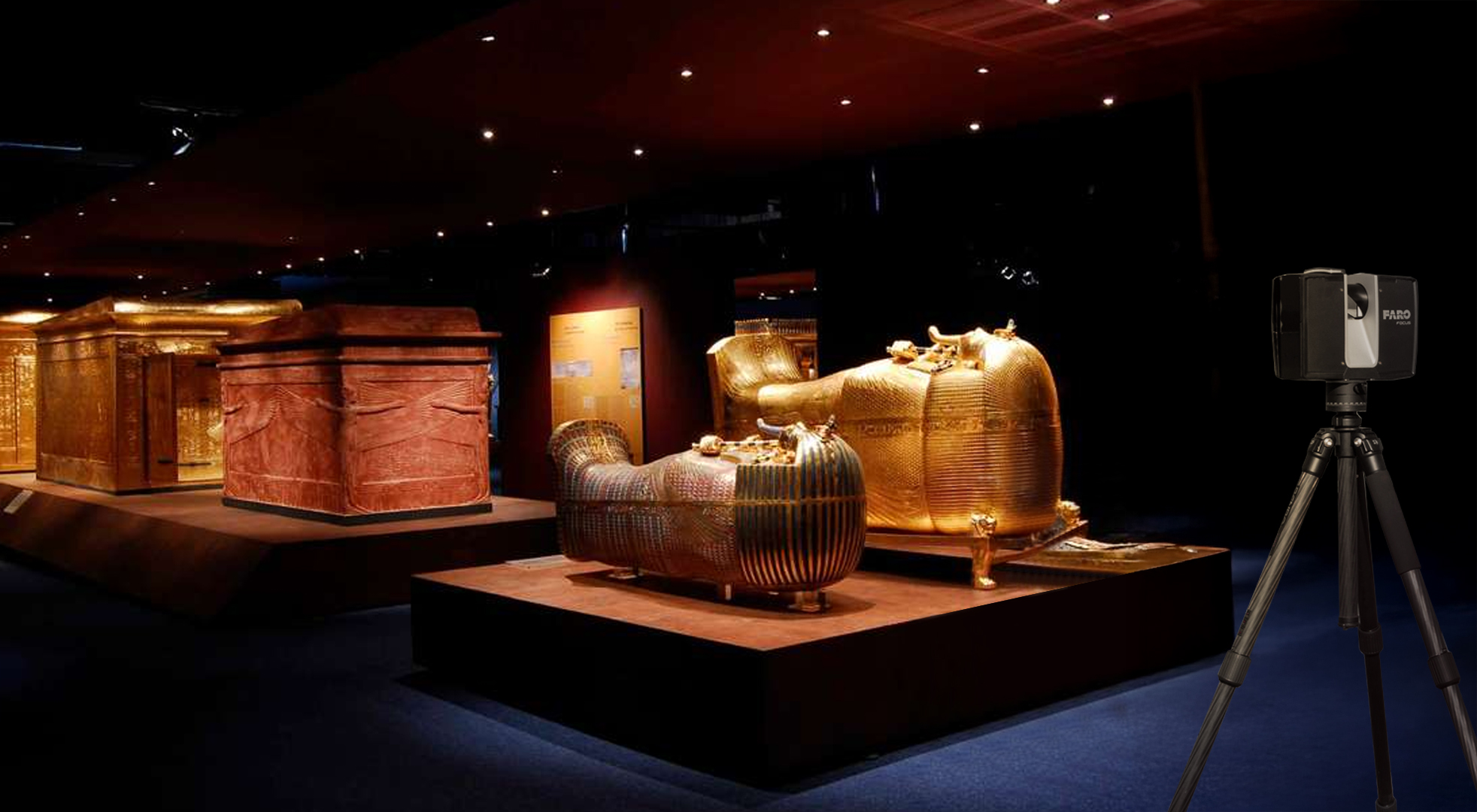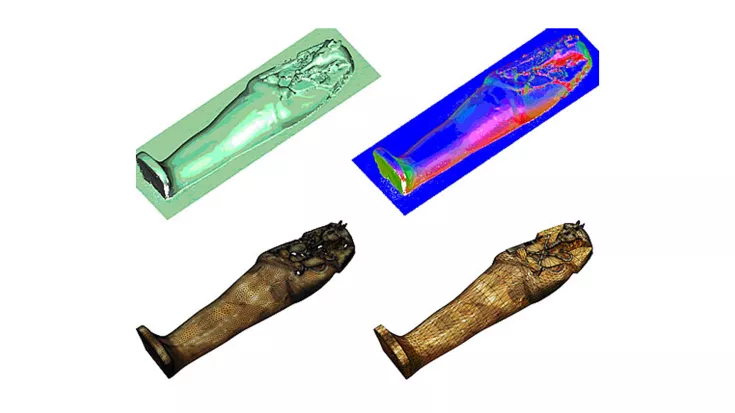3D laser scanning and Tutankhamun

TitleGeschichte neu erleben: Historische Stätten in 3D dank Laserscanning
Ausstellungs- und Museumsbesucher haben jetzt die Möglichkeit bedeutende historische Fundstücke, Bauwerke und Denkmäler realitätsnah auch zu Hause in 3D erleben und bestaunen zu können. Dank Laserscanning müssen Sie sich nicht mehr bloß mit Fotos und Miniaturnachbildungen der Originale begnügen, sondern bekommen eine identische, millimetergenaue Reproduktion des Originals zu Gesicht. So wird Geschichte noch spannender! Die Ausgrabungsfunde der mehr als 12.000 Jahre alten Tempelanlage Göbekli Tepe die sich im Südosten der Türkei befindet und als eine der interessantesten, archäologischen Entdeckungen der letzten Jahre gilt, wurden mithilfe von Laserscanning dreidimensional digitalisiert und anschließend detailgetreu rekonstruiert. 3D-Laserscanner wurden auch für die Restaurierungsarbeiten der Tempelstätte Angkor in Kambodscha verwendet, die seit 1992 zum UNESCO Weltkulturerbe zählt.
TitleDie Ausstellung „Tutanchamun“
Im Rahmen der Ausstellung „Tutanchamun – Sein Grab und die Schätze“ wurden die Sarkophage sowie ausgewählte Grabbeigaben des berühmten altägyptischen Pharaos dreidimensional dokumentiert und rekonstruiert. Die bedeutenden Fundstücke wurden dafür mit einem Faro Photon Laserscanner von dem deutschen Unternehmen Laserscanning Europe GmbH berührungslos vermessen. Das europaweit agierende Systemhaus ist auf dem Laserscanning-Markt fest etabliert und stellt seine langjährige Erfahrung und sein fachspezifisches Wissen sowohl Herstellern als auch Anwendern zur Verfügung. Objekte werden beim Laserscanning mithilfe von Laserstrahlen punktweise abgetastet und die reflektierten Laserpulse werden gemessen. Die Laserscanner-Daten der einzelnen Aufnahmen werden anschließend zusammengeführt, ausgewertet und können als Punktewolke dreidimensional dargestellt werden. Auch die Oberflächenbeschaffenheit (Reflexionseigenschaft) des Objekts wird erfasst und farbig im Laserscan dargestellt (Intensitätsbild). Diese Daten dienen als Grundlage, um wirklichkeitsgetreue, digitale 3D-Modelle – also exakte, geometrische Nachbildungen – zu erzeugen. Mit Hilfe geeigneter Fototexturen können daraus realitätsnahe, virtuelle 3D-Abbilder der historischen Originale generiert werden.
TitleLaserscandaten Verarbeitung für die „Tutanchamun-Ausstellung“
Bei der Bearbeitung der Laserscanner-Daten der Tutanchamun-Ausstellung wurde eine am Institut für Photogrammetrie und Fernerkundung der TU Wien entwickelte kosten- und zeitsparende Methode der Prozessierung und Auswertung der Daten angewandt, die den Aufwand durch hohe Automatisierung stark reduziert. Kleine, systematische Fehler wurden zudem eliminiert und die generierte Punktewolke mittels Triangulation modelliert. Die direkte Weiterverarbeitung dieser Modelle erfolgte durch die Firma a:xperience. Ziel ist die Erstellung interaktiver Echtzeit-3D-Applikationen für unterschiedliche Medien wie Internet, DVD, mobile Endgeräte (z.B. iPhone Applikationen) oder Ausstellungsbespielungen, um die Kunstgegenstände dreidimensional erlebbar zu machen. Für die Exponate der Tutanchamun-Ausstellung bedeutet dies, dass der virtuelle Besucher die wertvollen Gegenstände erstmals seit ihrer Entdeckung wieder in ihrer ursprünglichen Umgebung, der Grabkammer, genau unter die Lupe nehmen kann. Das Grab des Pharaos wird somit greifbar nah.
From now on, individuals can see and explore historical buildings, monuments and cultural heritage of peoples not only at exhibitions but also at home and in the form of realistic 3D models. Thanks to the sophisticated laser scanning technique used to create identical reproductions of original items, you will have the opportunity to see and examine extremely accurate reproductions of historical items formerly only available in the form of photos or as small models. That makes history more exciting than ever before! The archaeological discovery of Göbekli Tepe dating back more than 12,000 years is regarded as a major find in recent years. Here, 3D laser scanning was used to create three-dimensional models and to reproduce it in an accurate and precise manner. 3D laser scanners were also used for restoration purposes of ancient temples situated in the Angkor region (Cambodia), which has been a registered UNESCO Cultural Heritage of the World since 1992.
The Tutankhamun exhibition
Within the framework of the exhibition “Tutankhamun: His Tomb and His Treasures”, sarcophagi, burial objects and treasures of the famous Egypt Pharaoh were reconstructed and digitalized in 3D. A Faro Photon laser scanner of the German service provider Laserscanning Europe GmbH was used to contactlessly scan significant archaeological finds of the Pharaoh. Laserscanning Europe GmbH, as an international company, is a well established business entity in Europe in the laser scanning industry and provides its expertise and technology to manufacturers, companies and end-users. Laser scanning uses tightly focused beams of laser light to contactlessly scan the surface of an object and measure the reflected light. Finally the collected laser scans are merged into one file, interpreted and then visualized in a three-dimensional point cloud. Even the surface condition and quality (reflectivity) of objects are scanned, which are then highlighted in color. This data forms the basis for faithful digital 3D models, or rather geometrically accurate replicas. That way, virtual 3D models of historical objects can be created as soon as appropriate textures are used.
Laser scanning data interpretation for Tutankhamun exhibition
Interpretation and analysis of laser scanning data of the Tutankhamun exhibition was performed on the basis of a very efficient technique developed at the Institute of Photogrammetry and Remote Sensing of the TU Vienna; being an automated procedure, this technique allows to reduce costs and time. Small systematic errors could be eliminated and the created point cloud was modeled using triangulation technique. Processing of the models was performed by a:xperience. The goal is to create interactive real-time 3D applications for different media, such as Internet, DVD, mobile phones (e.g. iPhone apps) and presentations, to bring a truly unique 3D experience to visitors that will show objets d'art as they were meant to be seen. That way, visitors can enjoy exhibits of the Tutankhamun exhibition, enabling them not only to discover interactive exhibits that give them an up-close view into lives and habits but also a personal view of the tomb. It makes you feel closer to reality than ever before.
Above: Point cloud (on the left: shading, on the right: locale positioning) Below: Models (on the left: triangulation, on the right: patches)
1: Anubis shrine, 2: figure of the king on a small boat (scapha), 3: canopic chest
